Feature-Rich Geometric and Electronic Properties of Carbon Nanoscrolls
Abstract
1. Introduction
2. Materials and Methods
3. Results and Discussion
3.1. Geometric Properties and Formation Energy
3.2. Electronic Properties
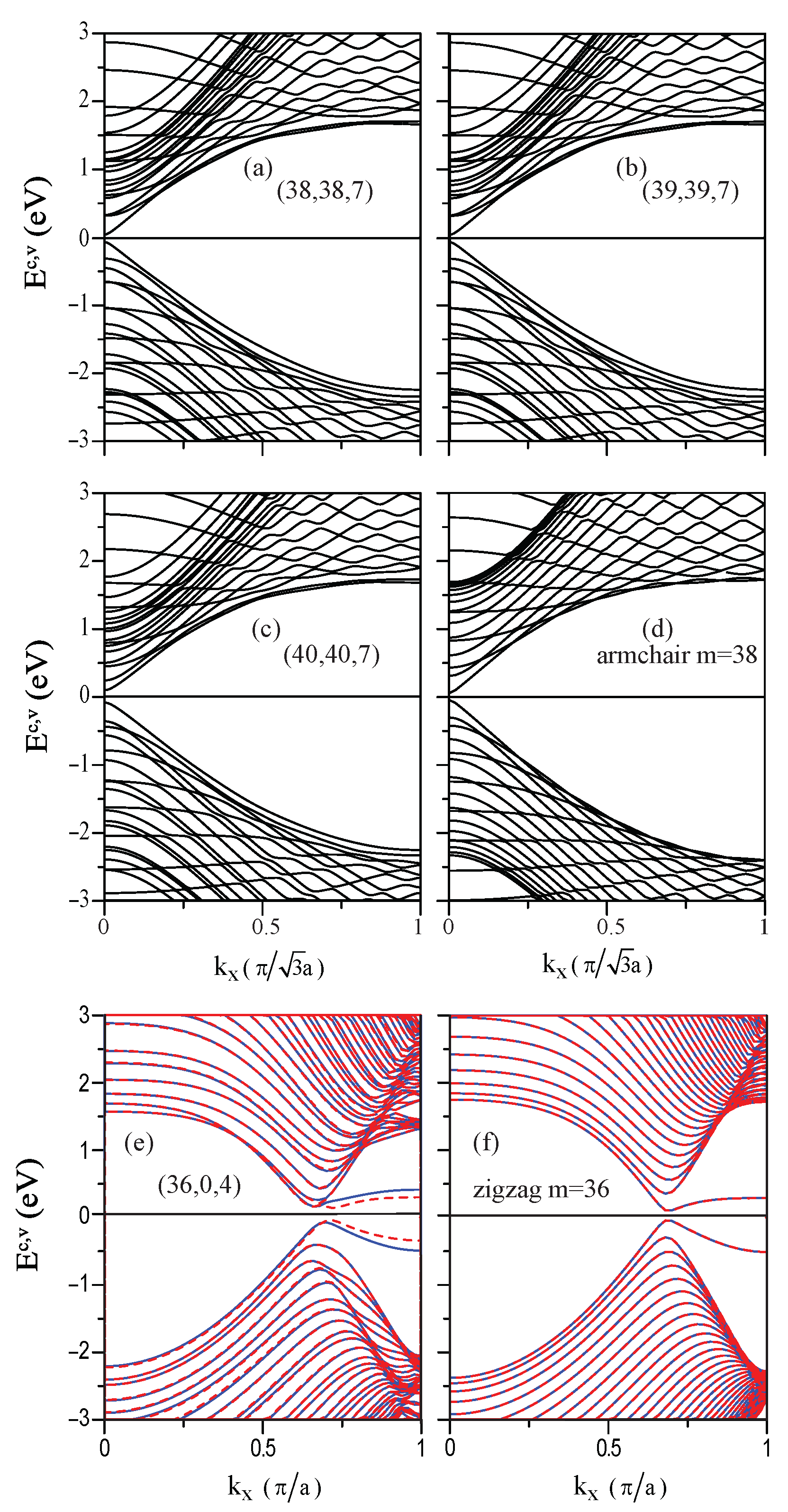
3.3. Charge Distributions
3.4. Density of States
3.5. Comparisons among the Planar, Curved/Zipped, Folded and Scrolled Systems
4. Conclusions
Author Contributions
Funding
Institutional Review Board Statement
Informed Consent Statement
Data Availability Statement
Conflicts of Interest
References
- Robertson, J. Diamond-like amorphous carbon. Mater. Sci. Eng. R Rep. 2002, 37, 129–281. [Google Scholar] [CrossRef]
- Grill, A. Diamond-like carbon: State of the art. Diam. Relat. Mater. 1999, 8, 428–434. [Google Scholar] [CrossRef]
- Graf, D.; Molitor, F.; Ensslin, K.; Stampfer, C.; Jungen, A.; Hierold, C.; Wirtz, L. Spatially resolved Raman spectroscopy of single-and few-layer graphene. Nano Lett. 2007, 7, 238–242. [Google Scholar] [CrossRef] [PubMed]
- Meyer, J.C.; Geim, A.K.; Katsnelson, M.I.; Novoselov, K.S.; Booth, T.J.; Roth, S. The structure of suspended graphene sheets. Nature 2007, 446, 60–63. [Google Scholar] [CrossRef] [PubMed]
- Gopinadhan, K.; Shin, Y.J.; Jalil, R.; Venkatesan, T.; Geim, A.K.; Neto, A.H.C.; Yang, H. Extremely large magnetoresistance in few-layer graphene/boron-nitride heterostructures. Nat. Commun. 2015, 6, 1–7. [Google Scholar] [CrossRef] [PubMed]
- Ren, Z.; Huang, Z.; Xu, J.; Wang, J.; Bush, P.; Siegal, M.; Provencio, P. Synthesis of large arrays of well-aligned carbon nanotubes on glass. Science 1998, 282, 1105–1107. [Google Scholar] [CrossRef] [PubMed]
- Wilder, J.W.; Venema, L.C.; Rinzler, A.G.; Smalley, R.E.; Dekker, C. Electronic structure of atomically resolved carbon nanotubes. Nature 1998, 391, 59–62. [Google Scholar] [CrossRef]
- Liao, M.; Jiang, S.; Hu, C.R.; Zhang, R.; Kuang, Y.M.; Zhu, J.Z.; Zhang, Y.; Dong, Z. Tip Enhanced Raman Spectroscopic Imaging of Individual Carbon Nanotubes with Sub-nanometer Resolution. Nano Lett. 2016, 16, 4040–4046. [Google Scholar] [CrossRef]
- Kosynkin, D.V.; Higginbotham, A.L.; Sinitskii, A.; Lomeda, J.R.; Dimiev, A.; Price, B.K.; Tour, J.M. Longitudinal unzipping of carbon nanotubes to form graphene nanoribbons. Nature 2009, 458, 872–876. [Google Scholar] [CrossRef]
- Kim, K.; Sussman, A.; Zettl, A. Graphene nanoribbons obtained by electrically unwrapping carbon nanotubes. ACS Nano 2010, 4, 1362–1366. [Google Scholar] [CrossRef] [PubMed]
- Chen, Y.C.; Cao, T.; Chen, C.; Pedramrazi, Z.; Haberer, D.; de Oteyza, D.G.; Fischer, F.R.; Louie, S.G.; Crommie, M.F. Molecular bandgap engineering of bottom-up synthesized graphene nanoribbon heterojunctions. Nat. Nanotechnol. 2015, 10, 156–160. [Google Scholar] [CrossRef] [PubMed]
- Chung, H.C.; Chang, C.P.; Lin, C.Y.; Lin, M.F. Electronic and optical properties of graphene nanoribbons in external fields. Phys. Chem. Chem. Phys. 2016, 18, 7573–7616. [Google Scholar] [CrossRef] [PubMed]
- Viculis, L.M.; Mack, J.J.; Kaner, R.B. A chemical route to carbon nanoscrolls. Science 2003, 299, 1361. [Google Scholar] [CrossRef] [PubMed]
- Savoskin, M.V.; Mochalin, V.N.; Yaroshenko, A.P.; Lazareva, N.I.; Konstantinova, T.E.; Barsukov, I.V.; Prokofiev, I.G. Carbon nanoscrolls produced from acceptor-type graphite intercalation compounds. Carbon 2007, 45, 2797–2800. [Google Scholar] [CrossRef]
- Shi, X.; Pugno, N.M.; Gao, H. Tunable core size of carbon nanoscrolls. J. Comput. Theor. Nanosci. 2010, 7, 517–521. [Google Scholar] [CrossRef]
- Daff, T.D.; Collins, S.P.; Dureckova, H.; Perim, E.; Skaf, M.S.; Galvão, D.S.; Woo, T.K. Evaluation of carbon nanoscroll materials for post-combustion CO2 capture. Carbon 2016, 101, 218–225. [Google Scholar] [CrossRef]
- Bacon, R. Growth, structure, and properties of graphite whiskers. J. Appl. Phys. 1960, 31, 283–290. [Google Scholar] [CrossRef]
- Xie, X.; Ju, L.; Feng, X.; Sun, Y.; Zhou, R.; Liu, K.; Fan, S.; Li, Q.; Jiang, K. Controlled fabrication of high-quality carbon nanoscrolls from monolayer graphene. Nano Lett. 2009, 9, 2565–2570. [Google Scholar] [CrossRef]
- Panchuk, R.; Prylutska, S.; Chumak, V.; Skorokhyd, N.; Lehka, L.; Evstigneev, M.; Prylutskyy, Y.I.; Berger, W.; Heffeter, P.; Scharff, P.; et al. Application of C60 fullerene-doxorubicin complex for tumor cell treatment in vitro and in vivo. J. Biomed. Nanotechnol. 2015, 11, 1139–1152. [Google Scholar] [CrossRef] [PubMed]
- Chang, C.H.; Ortix, C. Theoretical prediction of a giant anisotropic magnetoresistance in carbon nanoscrolls. Nano Lett. 2017, 17, 3076–3080. [Google Scholar] [CrossRef]
- Li, J.; Wang, L.; Jiang, W. Carbon microspheres produced by high energy ball milling of graphite powder. Appl. Phys. A 2006, 83, 385–388. [Google Scholar] [CrossRef]
- Haddon, R.; Hebard, A.; Rosseinsky, M.; Murphy, D.; Duclos, S.; Lyons, K.; Miller, B.; Rosamilia, J.; Fleming, R.; Kortan, A.; et al. Conducting films of C60 and C70 by alkali-metal doping. Nature 1991, 350, 320–322. [Google Scholar] [CrossRef]
- Kroto, H.W.; Allaf, A.; Balm, S. C60: Buckminsterfullerene. Chem. Rev. 1991, 91, 1213–1235. [Google Scholar] [CrossRef]
- Mpourmpakis, G.; Tylianakis, E.; Froudakis, G.E. Carbon nanoscrolls: A promising material for hydrogen storage. Nano Lett. 2007, 7, 1893–1897. [Google Scholar] [CrossRef] [PubMed]
- Coluci, V.; Braga, S.; Baughman, R.; Galvao, D. Prediction of the hydrogen storage capacity of carbon nanoscrolls. Phys. Rev. B 2007, 75, 125404. [Google Scholar] [CrossRef]
- Zhao, J.; Yang, B.; Zheng, Z.; Yang, J.; Yang, Z.; Zhang, P.; Ren, W.; Yan, X. Facile preparation of one-dimensional wrapping structure: Graphene nanoscroll-wrapped of Fe3O4 nanoparticles and its application for lithium-ion battery. ACS Appl. Mater. Interfaces 2014, 6, 9890–9896. [Google Scholar] [CrossRef] [PubMed]
- Shi, X.; Pugno, N.M.; Cheng, Y.; Gao, H. Gigahertz breathing oscillators based on carbon nanoscrolls. Appl. Phys. Lett. 2009, 95, 163113. [Google Scholar] [CrossRef]
- Wang, J.; Hao, J.; Liu, D.; Qin, S.; Chen, C.; Yang, C.; Liu, Y.; Yang, T.; Fan, Y.; Chen, Y.; et al. Flower stamen-like porous boron carbon nitride nanoscrolls for water cleaning. Nanoscale 2017, 9, 9787–9791. [Google Scholar] [CrossRef]
- Liu, Z.; Wang, J.; Ding, H.; Chen, S.; Yu, X.; Lu, B. Carbon nanoscrolls for aluminum battery. ACS Nano 2018, 12, 8456–8466. [Google Scholar] [CrossRef]
- Uhm, T.; Na, J.; Lee, J.U.; Cheong, H.; Lee, S.W.; Campbell, E.; Jhang, S.H. Structural configurations and Raman spectra of carbon nanoscrolls. Nanotechnology 2020, 31, 315707. [Google Scholar] [CrossRef]
- Braga, S.; Coluci, V.; Baughman, R.; Galvao, D. Hydrogen storage in carbon nanoscrolls: An atomistic molecular dynamics study. Chem. Phys. Lett. 2007, 441, 78–82. [Google Scholar] [CrossRef]
- Huang, Y.; Li, T. Molecular mass transportation via carbon nanoscrolls. J. Appl. Mech. 2013, 80, 040903. [Google Scholar] [CrossRef]
- Yan, M.; Wang, F.; Han, C.; Ma, X.; Xu, X.; An, Q.; Xu, L.; Niu, C.; Zhao, Y.; Tian, X.; et al. Nanowire templated semihollow bicontinuous graphene scrolls: Designed construction, mechanism, and enhanced energy storage performance. J. Am. Chem. Soc. 2013, 135, 18176–18182. [Google Scholar] [CrossRef] [PubMed]
- Tojo, T.; Fujisawa, K.; Muramatsu, H.; Hayashi, T.; Kim, Y.A.; Endo, M.; Terrones, M.; Dresselhaus, M.S. Controlled interlayer spacing of scrolled reduced graphene nanotubes by thermal annealing. RSC Adv. 2013, 3, 4161–4166. [Google Scholar] [CrossRef]
- Kresin, V.; Aharony, A. Fully collapsed carbon nanotubes. Nature 1995, 377, 1673–1686. [Google Scholar]
- Qian, D.; Wagner, G.J.; Liu, W.K.; Yu, M.F.; Ruoff, R.S. Mechanics of carbon nanotubes. Appl. Mech. Rev. 2002, 55, 495–533. [Google Scholar] [CrossRef]
- Son, Y.W.; Cohen, M.L.; Louie, S.G. Energy gaps in graphene nanoribbons. Phys. Rev. Lett. 2006, 97, 216803. [Google Scholar] [CrossRef]
- Kane, C.L.; Mele, E. Size, shape, and low energy electronic structure of carbon nanotubes. Phys. Rev. Lett. 1997, 78, 1932. [Google Scholar] [CrossRef]
- Shyu, F.L.; Lin, M.F. Electronic and optical properties of narrow-gap carbon nanotubes. J. Phys. Soc. Jpn. 2002, 71, 1820–1823. [Google Scholar] [CrossRef]
- Chang, S.L.; Wu, B.R.; Yang, P.H.; Lin, M.F. Curvature effects on electronic properties of armchair graphene nanoribbons without passivation. Phys. Chem. Chem. Phys. 2012, 14, 16409–16414. [Google Scholar] [CrossRef] [PubMed]
- Chang, S.L.; Lin, S.Y.; Lin, S.K.; Lee, C.H.; Lin, M.F. Geometric and electronic properties of edge-decorated graphene nanoribbons. Sci. Rep. 2014, 4, 1–8. [Google Scholar] [CrossRef] [PubMed]
- Hwang, E.; Adam, S.; Sarma, S.D. Carrier transport in two-dimensional graphene layers. Phys. Rev. Lett. 2007, 98, 186806. [Google Scholar] [CrossRef] [PubMed]
- Lai, Y.; Ho, J.; Chang, C.; Lin, M.F. Magnetoelectronic properties of bilayer Bernal graphene. Phys. Rev. B 2008, 77, 085426. [Google Scholar] [CrossRef]
- Chang, S.L.; Wu, B.R.; Wong, J.H.; Lin, M.F. Configuration-dependent geometric and electronic properties of bilayer graphene nanoribbons. Carbon 2014, 77, 1031–1039. [Google Scholar] [CrossRef]
- Lin, C.Y.; Wu, J.Y.; Ou, Y.J.; Chiu, Y.H.; Lin, M.F. Magneto-electronic properties of multilayer graphenes. Phys. Chem. Chem. Phys. 2015, 17, 26008–26035. [Google Scholar] [CrossRef] [PubMed]
- Feng, J.; Qi, L.; Huang, J.Y.; Li, J. Geometric and electronic structure of graphene bilayer edges. Phys. Rev. B 2009, 80, 165407. [Google Scholar] [CrossRef]
- Lin, S.Y.; Chang, S.L.; Shyu, F.L.; Lu, J.M.; Lin, M.F. Feature-rich electronic properties in graphene ripples. Carbon 2015, 86, 207–216. [Google Scholar] [CrossRef]
- Son, Y.W.; Choi, S.M.; Hong, Y.P.; Woo, S.; Jhi, S.H. Electronic topological transition in sliding bilayer graphene. Phys. Rev. B 2011, 84, 155410. [Google Scholar] [CrossRef]
- Tran, N.T.T.; Lin, S.Y.; Glukhova, O.E.; Lin, M.F. Configuration-induced rich electronic properties of bilayer graphene. J. Phys. Chem. C 2015, 119, 10623–10630. [Google Scholar] [CrossRef]
- Kresse, G.; Joubert, D. From ultrasoft pseudopotentials to the projector augmented-wave method. Phys. Rev. B 1999, 59, 1758. [Google Scholar] [CrossRef]
- Kresse, G.; Furthmüller, J. Efficient iterative schemes for ab initio total-energy calculations using a plane-wave basis set. Phys. Rev. B 1996, 54, 11169. [Google Scholar] [CrossRef]
- Grimme, S. Semiempirical GGA-type density functional constructed with a long-range dispersion correction. J. Comput. Chem. 2006, 27, 1787–1799. [Google Scholar] [CrossRef] [PubMed]
- Perdew, J.P.; Burke, K.; Ernzerhof, M. Generalized gradient approximation made simple. Phys. Rev. Lett. 1996, 77, 3865. [Google Scholar] [CrossRef] [PubMed]
- Lin, S.Y.; Chang, S.L.; Tran, N.T.T.; Yang, P.H.; Lin, M.F. H–Si bonding-induced unusual electronic properties of silicene: A method to identify hydrogen concentration. Phys. Chem. Chem. Phys. 2015, 17, 26443–26450. [Google Scholar] [CrossRef] [PubMed][Green Version]
- Chang, S.L.; Wu, B.R.; Yang, P.H.; Lin, M.F. Geometric, magnetic and electronic properties of folded graphene nanoribbons. RSC Adv. 2016, 6, 64852–64860. [Google Scholar] [CrossRef][Green Version]

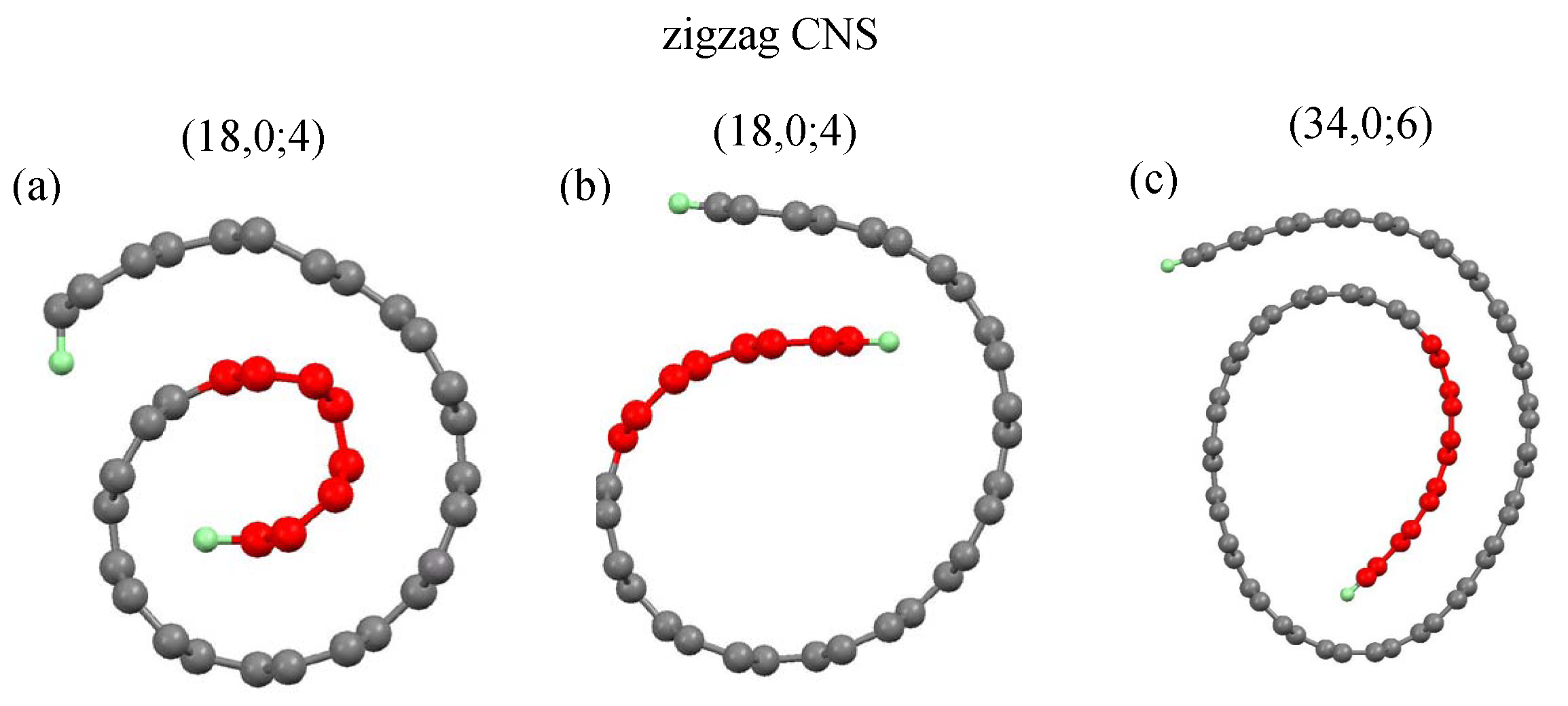
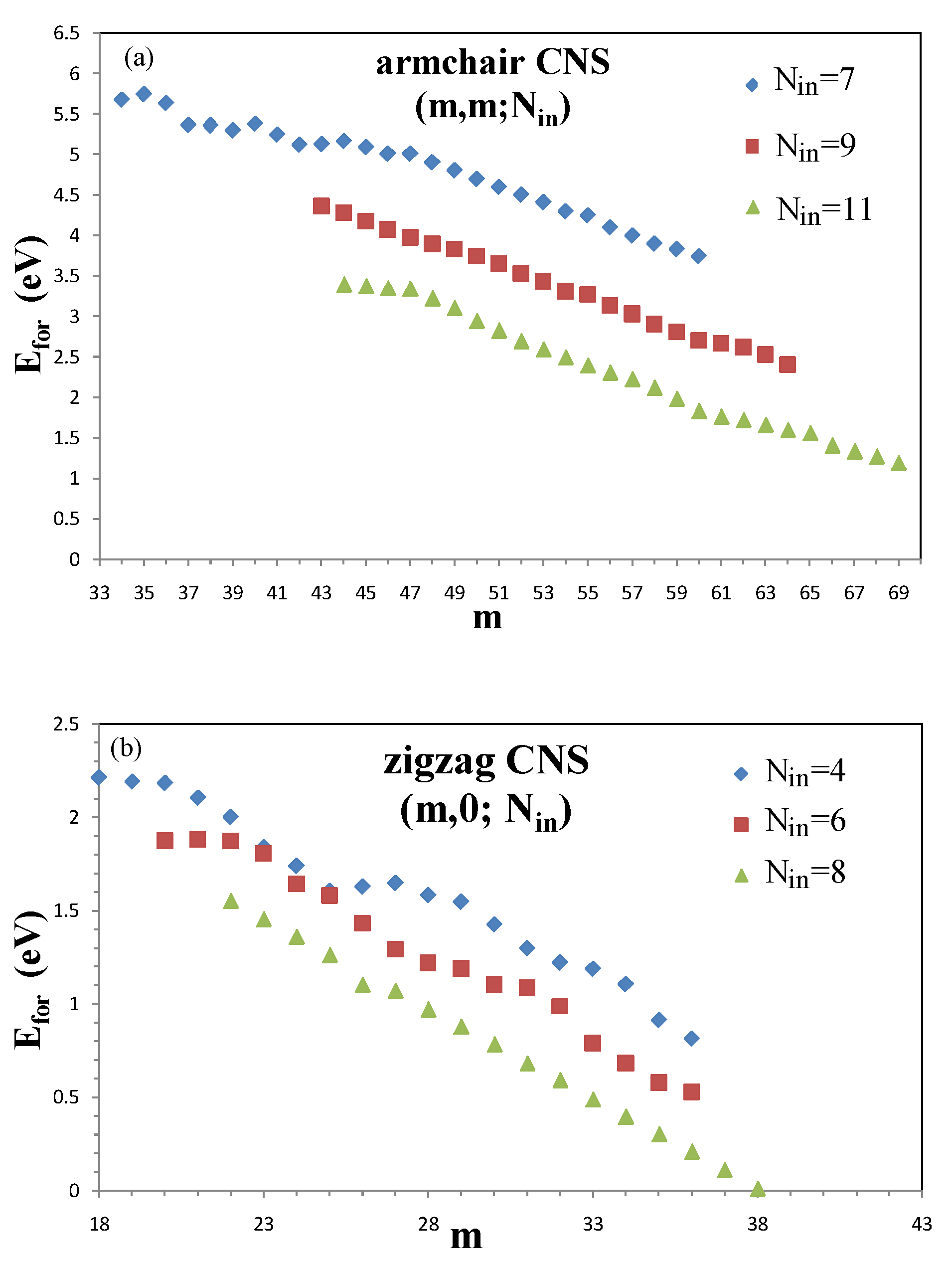
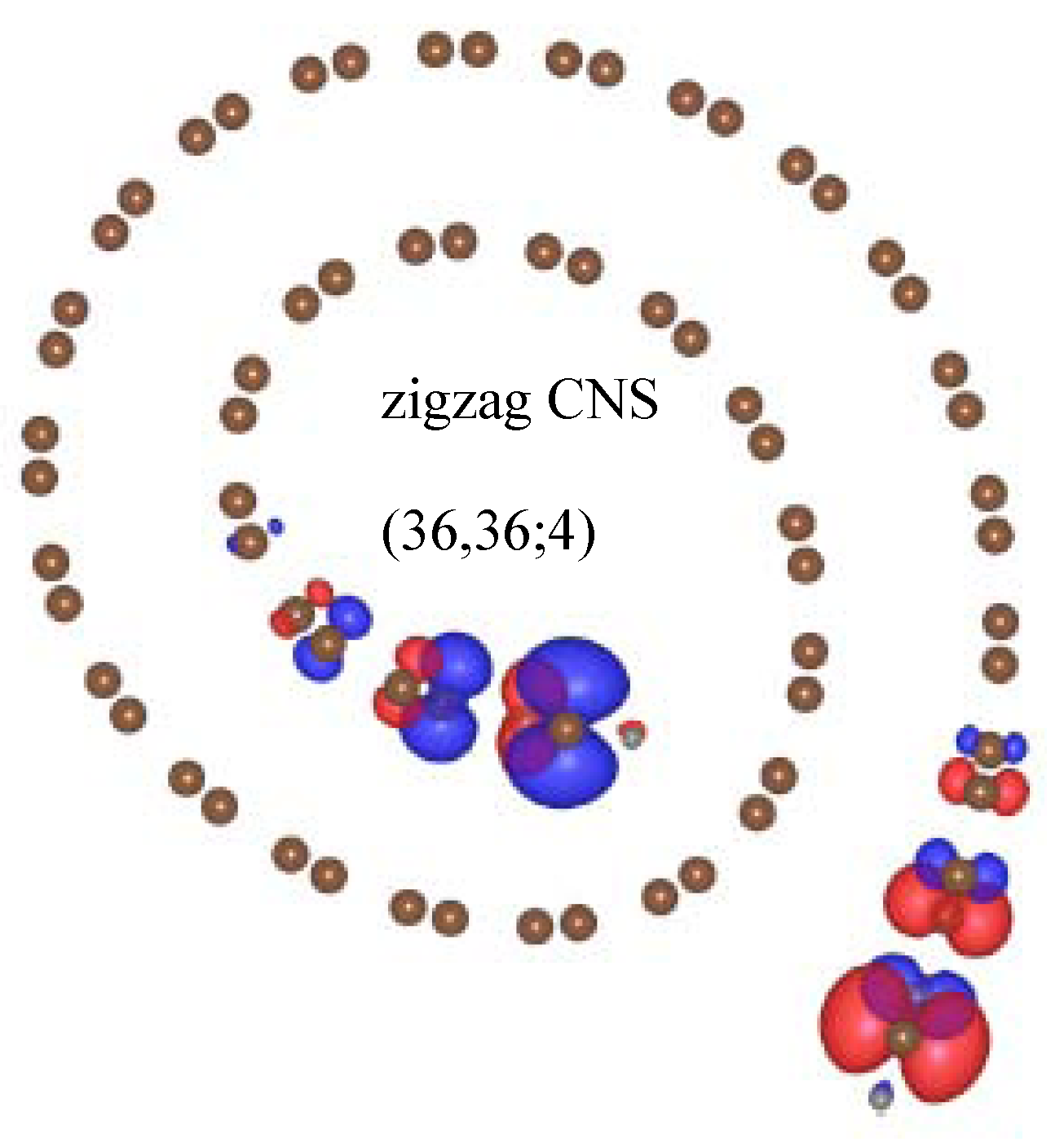
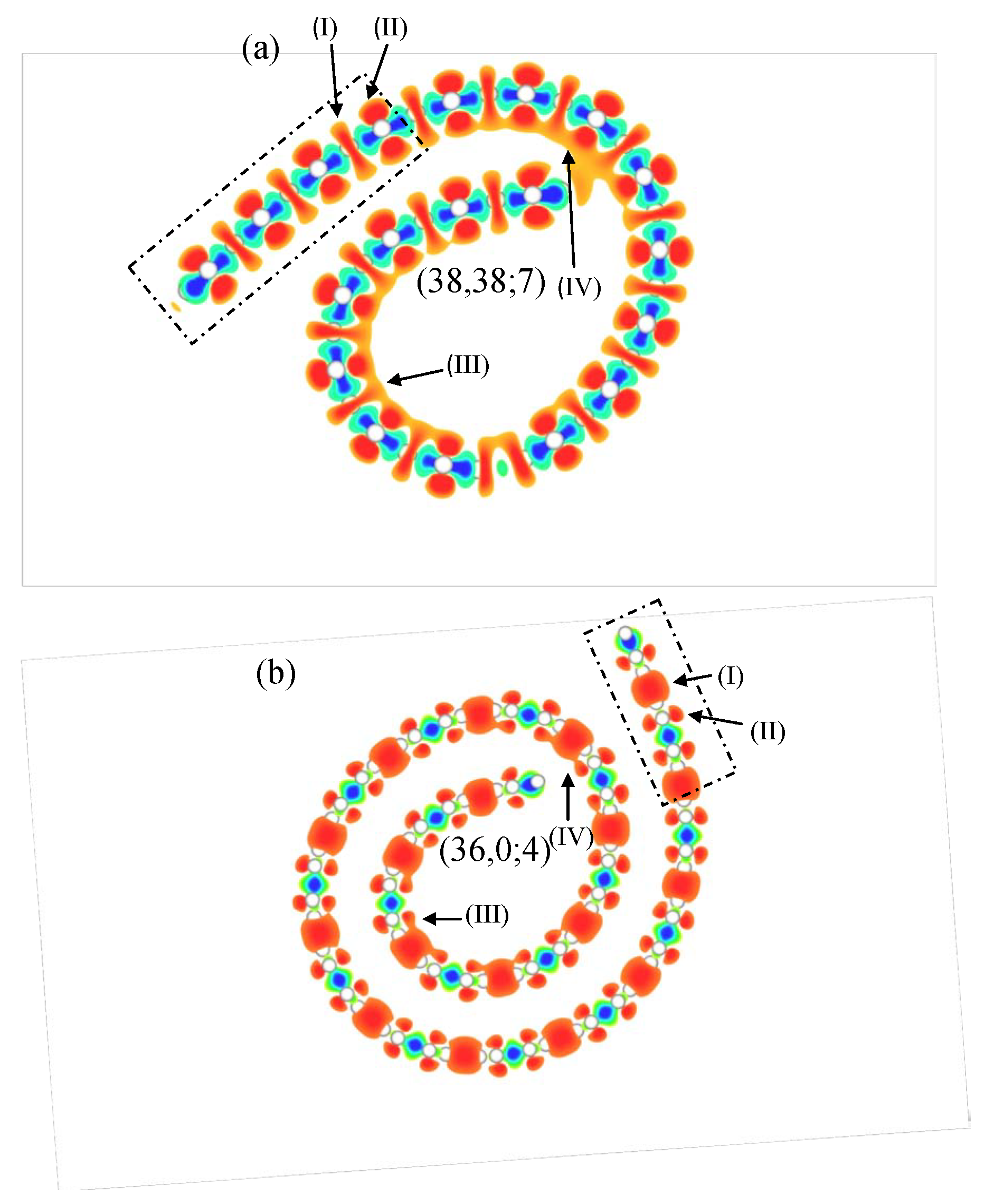
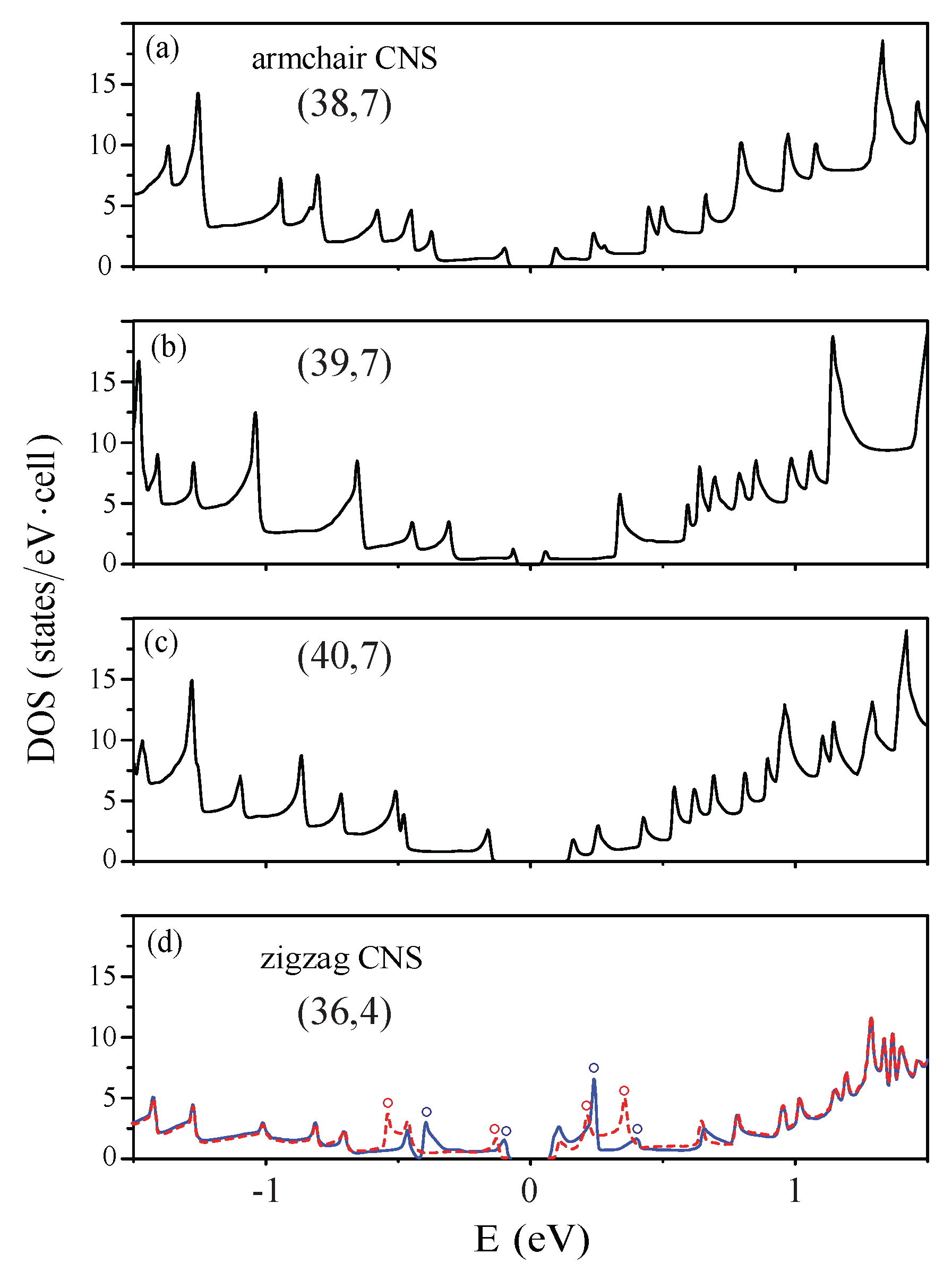
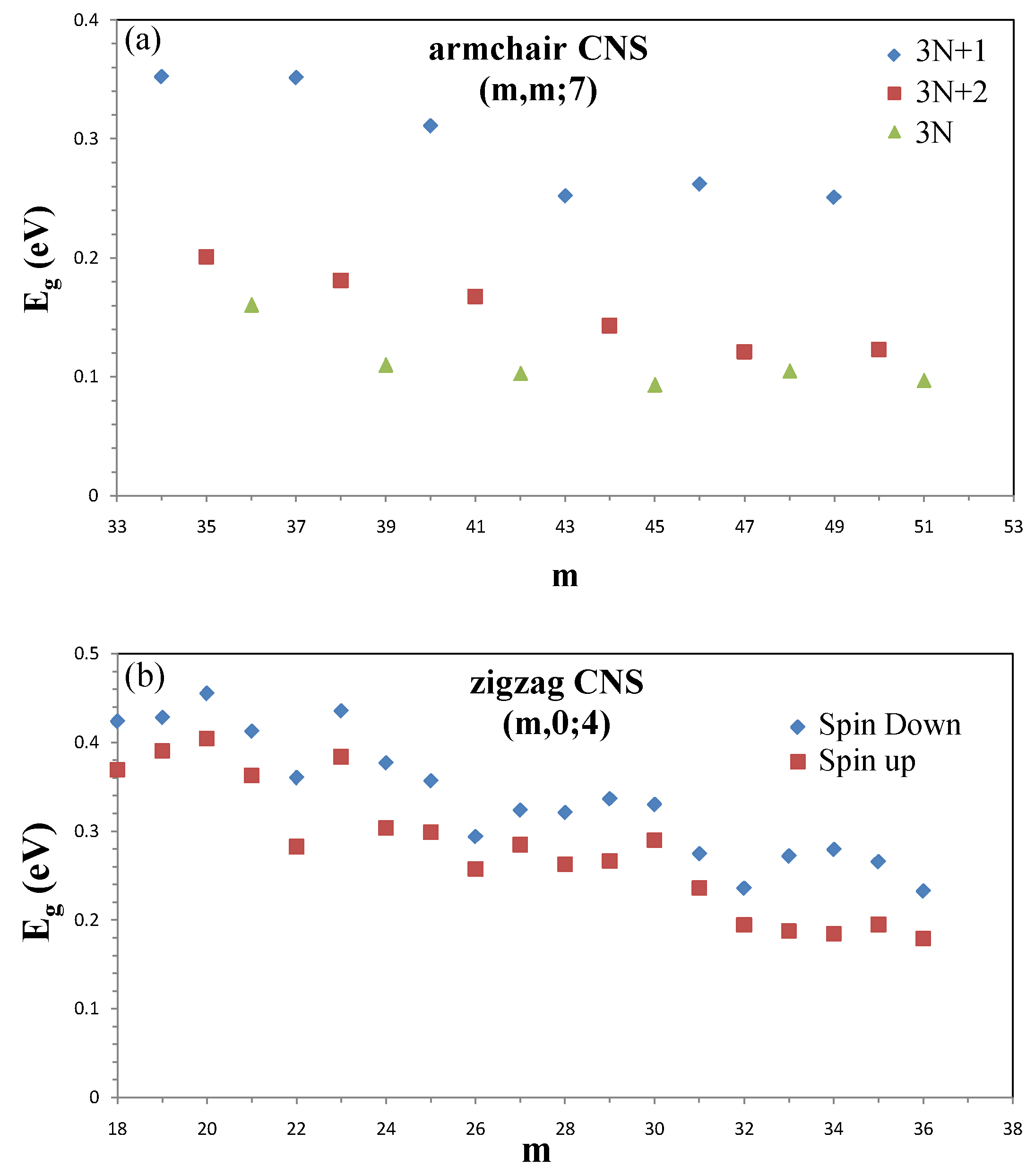
| Systems | Type | of HOS/LUS | Energy Gaps |
|---|---|---|---|
| Armchair CNS (38,38;7) | 3N+2 | 0.10/0.10 | direct; 0.181 eV |
| Armchair CNS (39,39;7) | 3N | 0.01/0.13 | indirect; 0.112 eV |
| Armchair CNS (40,40;7) | 3N+1 | 0.10/0.10 | direct; 0.323 eV |
| Zigzag CNS (36,0;4) | N/A | 0.67/0.67 | direct; 0.180/0.230 eV |
Publisher’s Note: MDPI stays neutral with regard to jurisdictional claims in published maps and institutional affiliations. |
© 2021 by the authors. Licensee MDPI, Basel, Switzerland. This article is an open access article distributed under the terms and conditions of the Creative Commons Attribution (CC BY) license (https://creativecommons.org/licenses/by/4.0/).
Share and Cite
Lin, S.-Y.; Chang, S.-L.; Chiang, C.-R.; Li, W.-B.; Liu, H.-Y.; Lin, M.-F. Feature-Rich Geometric and Electronic Properties of Carbon Nanoscrolls. Nanomaterials 2021, 11, 1372. https://doi.org/10.3390/nano11061372
Lin S-Y, Chang S-L, Chiang C-R, Li W-B, Liu H-Y, Lin M-F. Feature-Rich Geometric and Electronic Properties of Carbon Nanoscrolls. Nanomaterials. 2021; 11(6):1372. https://doi.org/10.3390/nano11061372
Chicago/Turabian StyleLin, Shih-Yang, Sheng-Lin Chang, Cheng-Ru Chiang, Wei-Bang Li, Hsin-Yi Liu, and Ming-Fa Lin. 2021. "Feature-Rich Geometric and Electronic Properties of Carbon Nanoscrolls" Nanomaterials 11, no. 6: 1372. https://doi.org/10.3390/nano11061372
APA StyleLin, S.-Y., Chang, S.-L., Chiang, C.-R., Li, W.-B., Liu, H.-Y., & Lin, M.-F. (2021). Feature-Rich Geometric and Electronic Properties of Carbon Nanoscrolls. Nanomaterials, 11(6), 1372. https://doi.org/10.3390/nano11061372





